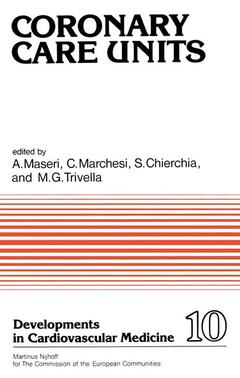Coronary Care Units, Softcover reprint of the original 1st ed. 1981 Proceedings of a European Seminar held in Pisa, Italy Developments in Cardiovascular Medicine Series, Vol. 10
Langue : Anglais
Coordonnateurs : Maseri A., Marchesi C., Chierchia S., Trivella M.G.

The dimensions of the socio-economic problem represented by ischemic heart disease require a concentration of effort for its treatment and prevention at least comparable to that in program for neoplastic disease. It appeared a logical conclusion of the work of the CMSI ad hoc group to organize a seminar on Perspectives of Coronary Care. Similar actions obviously are better undertaken at a supranational level because of: the dimension of the problem, the absence of expertises on all the different aspects in individual countries and the difference in patient population and in the phylosophy guiding the approach to coronary patients in different countries. The review of the recent literature and the results of the survey report on hemodynamic monitoring in coronary care units in the member countries (document for the CMSI 1979 - Pisa) indicate that this field is in the process of rapid transience because of accumulating information which appears to modify sUbstantially tradi tional concepts concerning patient management and prevention. While advanced technologies may potentially play a major role not only in diagnostic and therapeutic procedures but also in our understanding of disease processes, thus opening new lines for treatment and prevention, optimization of resources is a basic prerequisi te in the attempt of containing the budget for medical care. Hence we aimed to identify the technologies of immediate benefi t for extensive routine appl ications from those that should still be considered in the domain of research and development.
1: Perspectives on Arrhythmia Monitoring in Coronary Care Units.- 1.1. Introduction.- 1.2. Methods for detection of arrhythmias and their clinical significance.- 1.3. The natural course of ventricular arrhythmias in AMI.- 1.4. A computer assisted method for a quantitative evaluation of arrhythmias.- Discussion of Chapter 1.- 2: Non Invasive Hemodynamic Measurements in Coronary Care Units.- 2.1. Introduction.- 2.2. Two-dimensional echocardiography in acute myocardial infarction.- 2.3. Assessment of ventricular function in acute myocardial infarction by echocardiography: postmortem correlations.- 2.4. Preliminary evaluation of transcutaneous aortovelography for monitoring changes in cardiac output.- Discussion of Chapter 2.- 3: Hemodynamic Monitoring in Coronary Care Units.- 3.1. Why coronary care units are beneficial and cost-effective when they are used wisely.- 3.2. Hemodynamic monitoring in acute myocardial infarction for prognostic assessment of survival and incidence of reinfarction.- 3.3. Significance of prognostic indexes derived from hemodynamic monitoring in acute myocardial infarction.- 3.4. A system for real time hemodynamic monitoring in a research environment.- 3.5. Prognostic indices, trend detection and prediction techniques.- 3.6. Problems with instrumentation for monitoring.- Discussion of Chapter 3.- 4: Clinical Aspects and New Research Lines on Pre-Infarction Angina.- 4.1. Introduction.- 4.2. Preinfarction angina: review of 67 consecutive patients admitted to coronary care unit.- 4.3. Preinfarction angina: comparison between angina with and without ST segment elevation.- 4.4. Prognosis of anginal patients in coronary care units.- 4.5. Hemodynamic monitoring and pharmacological tests in patients with preinfarction angina in coronary care unit.- 4.6. The importance of evaluating coronary reserve in anginal patients in coronary care unit.- Discussion of Chapter 4.- 5: Precoronary Care.- 5.1. Introduction.- 5.2. A mobile service for intra-aortic balloon assistance in cardiogenic shock and refractory angina.- 5.3. Prehospital coronary care.- 5.4. A prospective randomized study on the effectiveness of a mobile coronary care unit in Gothenburg.- Discussion of Chapter 5.- 6: Expanding Role of Coronary Care Unit in the Community (Telephone transmission and ambulatory monitoring of ecg).- 6.1. Introduction.- 6.2. Available techniques for transmission of biosignals from patients or from peripherals to a central station.- 6.3. Automated system for interpretation of 24-hour ECG tape recordings.- 6.4. A software approach to rhythm and ST-T analysis of 24 hour ECG.- 6.5. Evaluation and clinical results of ASTRI program for ambulatory monitoring.- Discussion of Chapter 6.- Round Table.- Appendix A: Survey Report on Hemodynamic Monitoring in Coronary Care Unit.- A.1. Introduction.- A.2. Survey of the literature.- A.3. Report on the questionnaire.- A.4. Conclusions of the seminar: ‘Perspectives of coronary care units’.- A.5. Forseable concerted actions.- Appendix B.- Tables 1-4: Main characteristics of monitoring systems.- Table 5 (A, B, C): Centers surveyed and their activity.
Date de parution : 11-2011
Ouvrage de 308 p.
15.6x24.4 cm
Disponible chez l'éditeur (délai d'approvisionnement : 15 jours).
Prix indicatif 52,74 €
Ajouter au panierThème de Coronary Care Units :
Mots-clés :
© 2024 LAVOISIER S.A.S.



